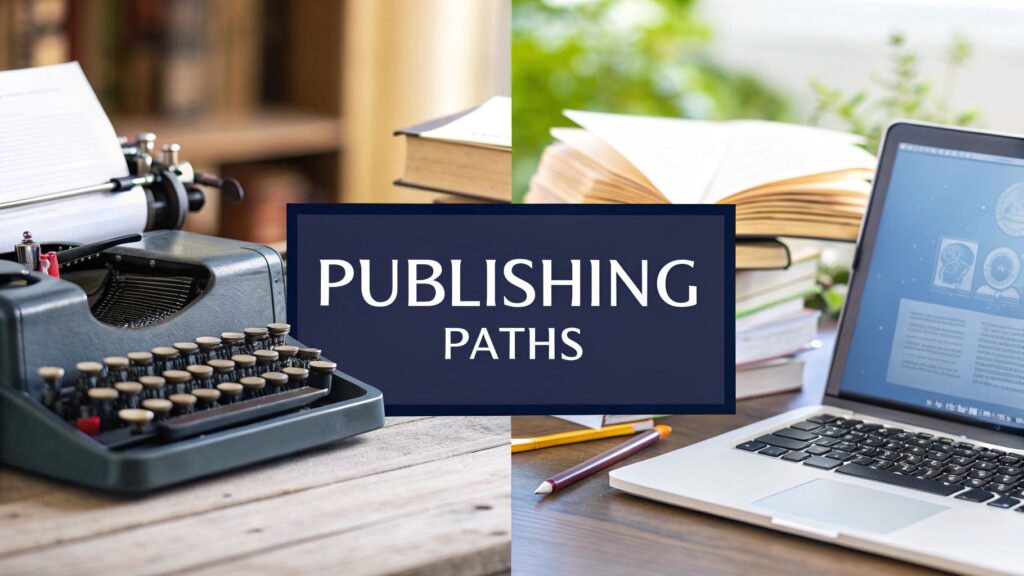The heart of the traditional vs self publishing debate is a classic trade-off. With traditional publishing, you get the validation and built-in support of a publishing house, but you give up a significant chunk of creative control and royalties. Self-publishing, on the other hand, grants you total creative freedom and a much bigger slice of the profit pie, but you're on the hook for every single aspect of production and marketing.
It really boils down to what you value more: external validation and a team behind you, or complete autonomy and a higher earning potential per book.
Understanding The Two Publishing Paths
Choosing how to get your book into the world is probably the biggest decision you'll make as an author. Each path comes with its own set of very different opportunities and headaches that can define your career. Getting a handle on these differences is the first step to making a smart choice that actually fits your goals.
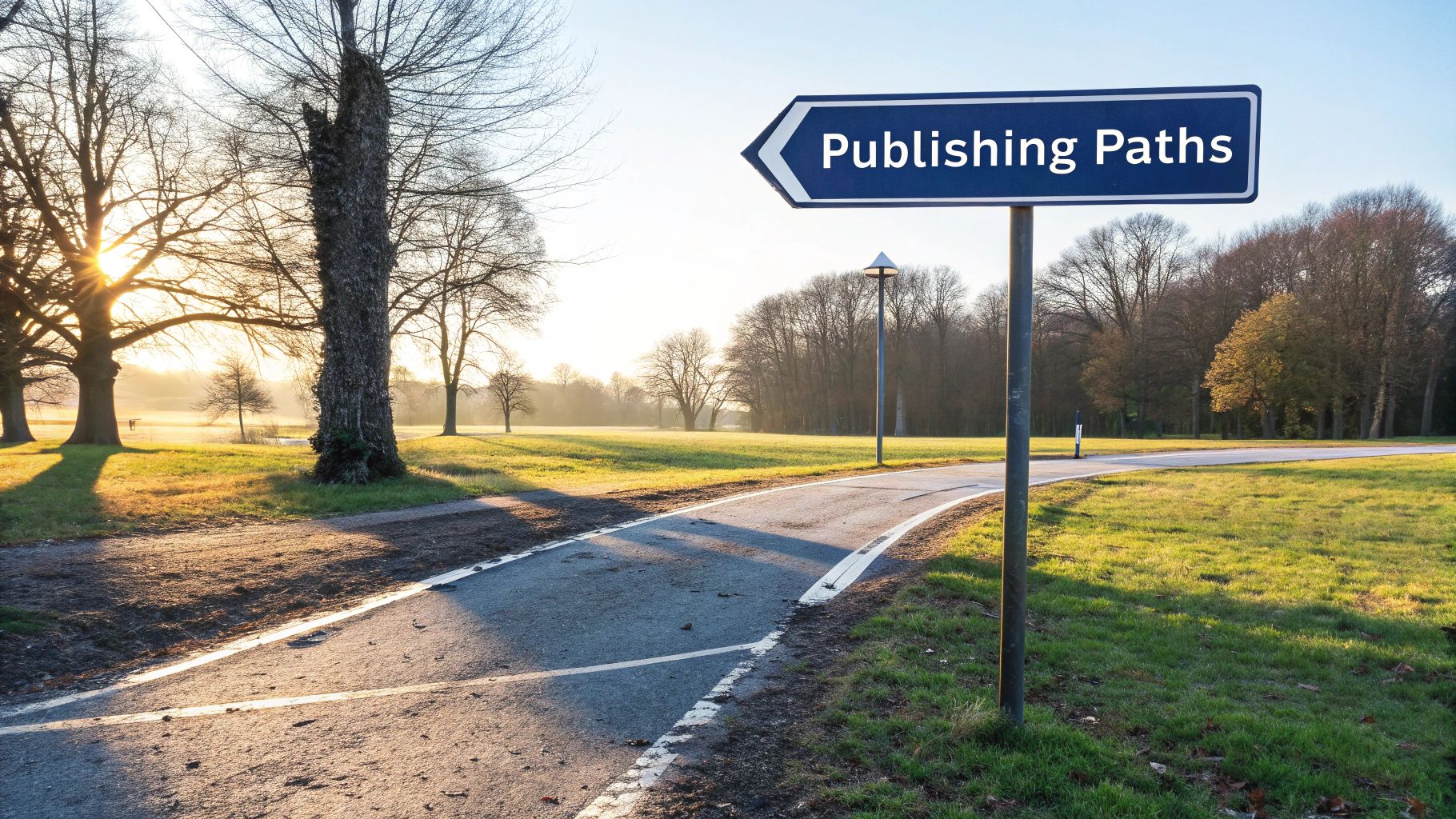
Let’s break down the two main models:
- Traditional Publishing: This is the route you see in movies. You write a manuscript, find a literary agent, and that agent sells your book to a publishing house. The publisher then fronts all the money for editing, cover design, printing, distribution, and marketing.
- Self-Publishing: This is the entrepreneurial route, often called "indie" publishing. Here, you are the publisher. You’re in the driver's seat for everything—from hiring an editor and cover designer to setting up distribution and running your own marketing campaigns.
Traditional Vs Self Publishing At a Glance
To see how these two paths stack up side-by-side, it helps to have a quick reference. This table cuts through the noise and lays out the core differences you'll be weighing.
| Attribute | Traditional Publishing | Self-Publishing |
|---|---|---|
| Upfront Cost | None for the author; the publisher invests their own money. | All costs are paid by the author, from editing to marketing. |
| Creative Control | Limited. The publisher has the final say on the cover, title, and even edits. | Complete control over every creative and business decision. |
| Royalty Rates | Much lower, typically 5-15% of net receipts. | Much higher, often 40-70% of the list price. |
| Speed to Market | Very slow. It can easily take 18-24 months from signing a contract to launch. | Fast. You can go from a finished manuscript to a live book in weeks. |
| Marketing | The publisher handles major marketing, but the author is still expected to do a lot. | The author is 100% responsible for all marketing and promotion. |
As you can see, the models are worlds apart. Each has distinct advantages depending on your situation.
The fundamental question isn't "Which path is better?" but rather "Which path is better for you and this specific book?" Your genre, career goals, and entrepreneurial spirit will heavily influence your decision.
Ultimately, both routes are completely valid ways to build a career. In fact, many successful authors now have hybrid careers, using both models for different books. For a closer look at the steps involved, check out our guide on how to become a published author. As we dig deeper into this comparison, you’ll get the clarity you need to pick the right direction for your manuscript.
The Evolving Publishing Landscape
The choice between traditional and self-publishing isn't what it used to be—a clear line between a "real" career and a side hobby. For decades, getting a book published meant navigating a fortress. Literary agents and editors were the gatekeepers, and for most authors, the only legitimate path to a bookshelf ran straight through a major publishing house in New York.
But the ground has shifted beneath our feet. The explosion of digital platforms, especially Amazon's Kindle Direct Publishing (KDP), has completely upended that old model. This change has put the power directly into authors' hands, giving them the tools to connect with a global audience without ever needing an agent's nod or a publisher's contract.
What was once a fringe alternative is now a dominant force in the industry. And this isn't just a feeling; the data tells a compelling story of a new, author-driven era.
The Surge of Independent Authors
The clearest signal of this industry-wide shift is the sheer number of self-published books hitting the market. Indie authors aren't a small group anymore. They've become a major source of new content, a fact that highlights just how much the business of making and selling books has changed.
Recent numbers from Bowker really drive this home. In 2023, the count of self-published books with registered ISBNs jumped by 7.2%, adding up to over 2.6 million new titles. Meanwhile, traditionally published books actually saw a 3.6% decline, with about 563,000 releases. Diving into the full report on these publishing trends gives you a detailed breakdown of the figures.
This infographic helps visualize the growing market share and output of self-published work compared to the traditional side of the industry.
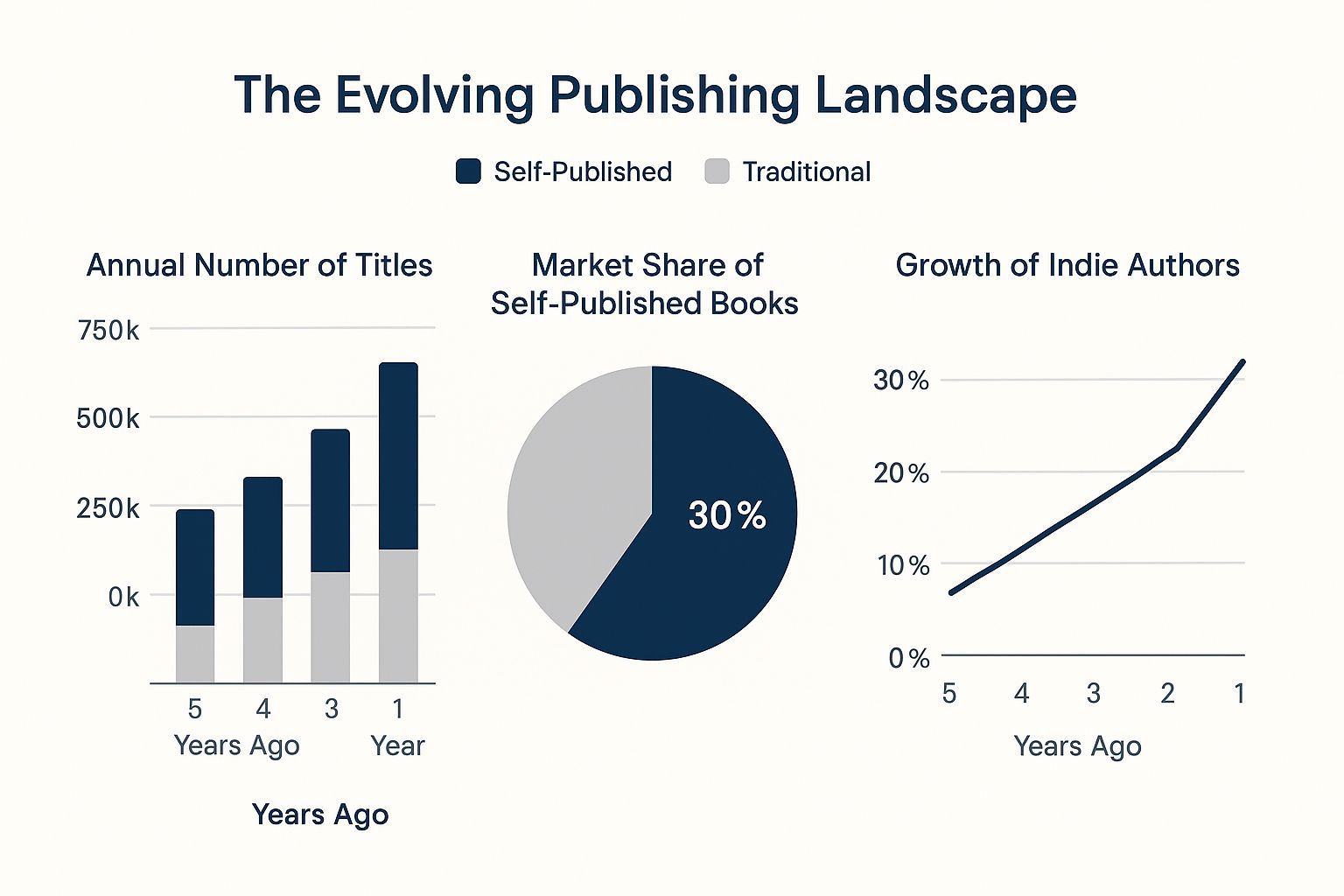
The numbers don't lie. Not only are indie authors releasing more books, but they're also carving out a bigger piece of the market pie year after year.
What This New Landscape Means for You
All this change gives today's authors an incredible amount of flexibility and opportunity. It makes the traditional vs. self-publishing debate more interesting than ever. Both paths have real advantages, and the right choice depends entirely on your specific goals, your genre, and how much of an entrepreneur you want to be.
The modern publishing landscape has created a powerful hybrid reality. An author can now strategically choose the best path for each project, leveraging traditional prestige for one book and capitalizing on the speed and higher royalties of self-publishing for another.
Think about it this way: a debut novelist might fight for a traditional deal to get that stamp of validation and see their book in stores across the country. Later on, they could self-publish a series of companion novellas, using the quick release schedule and better ebook royalties to build a loyal audience and create a steady income stream.
This kind of strategic career management simply wasn't an option fifteen years ago. Grasping this context is the first step toward making a smart, powerful choice for your own writing journey.
A Detailed Comparison of Publishing Models
Choosing between traditional and self-publishing is one of the most consequential decisions you'll make as an author. This isn't just about how your book gets made; it's a choice that shapes your career, your finances, and your creative life. To make the right call, we need to move beyond the surface-level pros and cons and dig into how each model works in the real world.
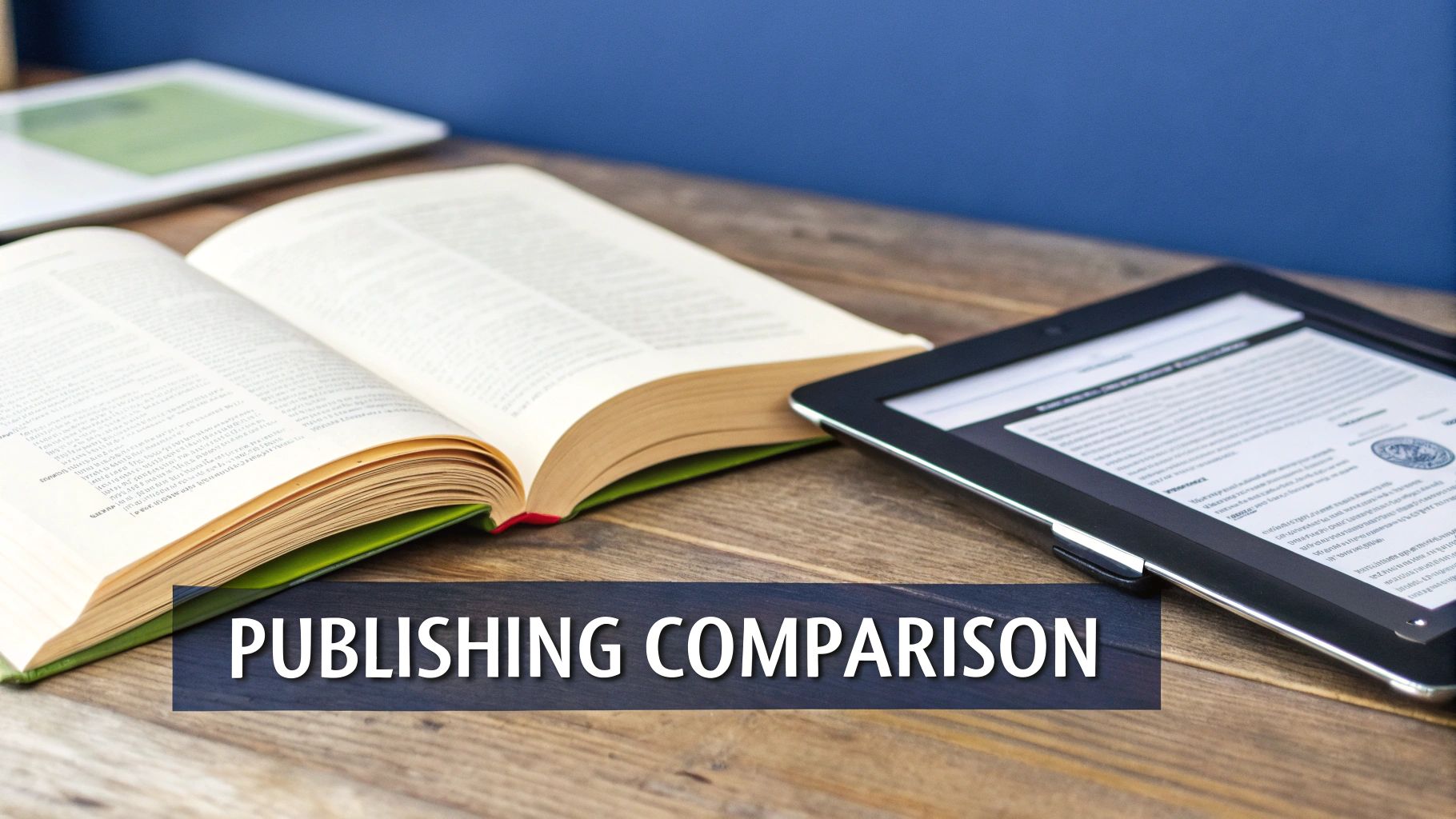
Let's break down the key differences that will directly impact your journey from manuscript to published book.
Creative Control and Rights Ownership
Who gets the final say on your book's cover, title, and even the words inside? This is arguably the most fundamental difference between the two paths.
When you sign a traditional publishing contract, you're essentially selling the rights to your book. The publisher invests in your work, and in return, they take the lead on making it commercially viable. This means their team has the final authority on critical creative elements.
- Cover Design: Their art department will create a cover based on market trends and genre expectations. Your input is considered, but the final design is their call.
- Title Changes: If the marketing team believes a different title will sell more copies, they have the right to change it.
- Editorial Direction: You'll work with a professional editor, but they have the final say on content changes, which can sometimes steer your story in a new direction.
Self-publishing is the complete opposite. You are the publisher. This puts you in the driver's seat with 100% creative control. Every decision—from the font used in the chapter headings to the final cover art—is yours to make. You also retain all rights to your work, which means you control foreign translations, audiobooks, and any potential film deals.
The core trade-off is clear: Traditional publishing offers expert guidance at the cost of final authority, while self-publishing provides absolute freedom but demands you make every creative decision correctly.
The Publication Process and Timeline
How soon do you want to hold your book in your hands? The timelines for these two models are worlds apart.
The traditional route is a marathon, not a sprint. It’s a slow, deliberate process that involves finding an agent, submitting to publishers, signing a contract, and then navigating multiple rounds of editing and design. It’s not uncommon for this entire process to take 18 to 24 months from signing the deal to seeing your book on a shelf. Publishers work on long production cycles, and your book has to find its place in their schedule.
Self-publishing, on the other hand, moves at the speed you set. As soon as your manuscript is edited, formatted, and has a cover, you can upload it to a platform like Amazon KDP and make it available for sale globally within days. This speed is a massive advantage for authors writing on timely topics or for those who write quickly and want to build a large catalog of books.
Distribution and Market Reach
Both paths aim to get your book to readers, but they take very different roads to get there.
Traditional publishers are masters of print distribution. They have long-standing, powerful relationships with wholesalers, distributors, and bookstores. This gives your book a real shot at being physically present on the shelves of major chains like Barnes & Noble and your local independent bookstore. That kind of retail presence is incredibly difficult for an individual author to achieve.
Self-publishing, however, was born from the internet and absolutely dominates the digital space. With platforms like Amazon, you gain immediate access to the world’s largest online bookstore. While print-on-demand (POD) services make your paperback available for anyone to order, getting it stocked on a physical shelf remains a major hurdle. The power here lies in direct, global access to a massive online audience.
Financial Investment and Upfront Costs
The flow of money is another area where the two models are direct opposites. It really comes down to one question: whose money is at risk?
With a traditional publisher, they carry the financial load. You pay nothing out of pocket. In fact, they pay you. The publisher covers all the professional costs:
- Comprehensive editing (developmental, copyediting, and proofreading)
- Professional cover design and interior layout
- Printing, shipping, and warehousing inventory
- Distribution logistics and marketing campaigns
Typically, you’ll receive an advance, which is a payment made against your future royalties. The publisher is betting that your book will earn back this investment and then some.
In self-publishing, you become the entrepreneur. You are responsible for funding the entire project yourself. These upfront costs can range from a few hundred dollars for a simple project to several thousand for a high-quality production that rivals a traditionally published book. If you're wondering what a realistic budget looks like, it's worth exploring what it costs to self-publish a book to get a detailed breakdown. While this investment is a significant barrier for many, it also means you're building an asset that you own completely.
To help you see these differences side-by-side, let's break them down into a more detailed comparison.
Detailed Feature Breakdown Traditional vs Self-Publishing
The table below offers a granular look at how each model handles the key stages of bringing a book to life, helping you weigh the practical implications of your choice.
| Aspect | Traditional Publishing | Self-Publishing | Key Consideration for Authors |
|---|---|---|---|
| Upfront Cost | $0. The publisher covers all costs and pays the author an advance. | $500 – $5,000+. The author funds everything (editing, design, marketing). | Your personal budget and willingness to invest in your own project. |
| Creative Control | Low. The publisher has the final say on the cover, title, and edits. | Total. The author makes all creative decisions. | How important is it for you to maintain your original vision without compromise? |
| Time to Market | Slow (18-24 months). A long, multi-step process from contract to launch. | Fast (Weeks to Months). You control the timeline. | Are you writing on a timely topic or do you want to publish frequently? |
| Royalties | Lower (5-15%). Royalties are a small percentage of net receipts. | Higher (40-70%). You keep a much larger share of the book's price. | Are you aiming for a larger advance or higher long-term earning potential per book? |
| Distribution | Strong in Print. Excellent access to physical bookstores. | Strong in Digital. Global reach via online retailers like Amazon. | Where is your target audience most likely to discover and buy your book? |
| Marketing | Team Support. The publisher has an in-house team, but the focus is often on lead titles. | Author-Driven. You are solely responsible for all marketing efforts. | How skilled and willing are you to actively market and promote your own book? |
| Validation | Built-in. Getting a deal is seen as a mark of industry validation. | Market-based. Validation comes from sales, reviews, and reader feedback. | Is external validation from industry gatekeepers important for your career goals? |
| Rights Ownership | Publisher Owned. You sell most rights (print, audio, film) for a set term. | Author Owned. You retain 100% of all rights to your work. | Do you want to control subsidiary rights (like film or foreign) yourself? |
This breakdown makes it clear that there's no single "best" path. The right choice depends entirely on your personal goals, resources, and the kind of career you want to build as an author.
Breaking Down Author Earnings and Royalties
For most writers, the whole traditional vs. self-publishing debate eventually comes down to one thing: money. The financial models couldn't be more different, and your choice will directly shape your income—from what you make upfront to your long-term earnings per book. Getting a handle on these numbers is essential if you want to make a smart decision that actually aligns with your financial goals.
The Traditional Publishing Model: The Advance
Traditional publishing runs on an advance-and-royalty system. When a publisher buys your book, they often pay you an "advance," which is a lump sum of money paid against your future royalties. Think of it as the publisher's bet on your book's success.
You won't see another dime from sales until your book "earns out." This means your share of the royalties has to add up to the total amount of your advance. Once you've cleared that hurdle, you'll start receiving royalty checks, which are typically paid out just twice a year.
A Look at Traditional Royalty Rates
In a traditional deal, you're earning a relatively small percentage of the book's price. The exact figures will be in your contract, but they generally fall into these ranges:
- Hardcover: 10% to 15% of the retail price
- Trade Paperback: 6% to 8% of the retail price
- Ebook: 25% of the publisher's net receipts (a crucial distinction, as this isn't the cover price)
The publisher takes the lion's share because they're fronting all the financial risk and covering the substantial costs of editing, printing, distribution, and marketing.
The Self-Publishing Model: Higher Royalties, Higher Risk
Self-publishing completely flips this model around. Forget about an advance; you're the one paying for everything upfront. But the payoff for that risk and investment is a much, much bigger slice of the revenue from every single book you sell.
Instead of a tiny percentage, you get a direct cut based on the platform's terms. On a platform like Amazon KDP, for instance, you can pocket up to 70% on ebooks and 60% on paperbacks (after printing costs are deducted). This direct payment means you stand to earn a whole lot more from each individual sale.
Here’s the fundamental trade-off: Traditional publishing might give you an upfront paycheck (the advance) but delivers lower per-book earnings over the long haul. Self-publishing requires your own initial investment but offers significantly higher royalties and much faster payouts.
A Real-World Earnings Scenario
Let's run the numbers to see just how stark the difference can be. It's often an eye-opener.
Self-published authors can see royalty rates of 60-70%, which blows the typical 15% from a traditional deal out of the water. Let’s imagine a paperback priced at $14.99. A self-published author might earn around $5.95 per sale after the printing cost is taken out. Sell 6,000 copies, and that’s $35,700 in your pocket.
Now, let's look at the same scenario for a traditionally published author. Selling the same 6,000 copies at the same price, their earnings would likely be closer to $8,940. You can dive deeper into these calculations and learn more about publishing royalties to see how different factors can change an author's final take-home pay.
This simple example shows the massive earning potential that comes with higher royalty rates. While an advance from a publisher feels great and offers some immediate security, the long-term income from a successful self-published book can dwarf what a traditional contract offers. This is especially true for authors who are willing to market their own work and cultivate a direct relationship with their readers. The real question is whether you want a smaller, guaranteed piece of the pie or a riskier, but potentially much larger, one.
Getting Your Book in Front of Readers: Marketing and Promotion
So, your book is finally finished. Now what? How do you get it from your hard drive into the hands of eager readers? This is where we hit one of the biggest myths in the traditional vs. self-publishing debate. Aspiring authors often picture a traditional deal as a golden ticket to a huge, well-oiled marketing machine, while self-publishing feels like screaming into a hurricane alone. The truth today is a lot more complicated.
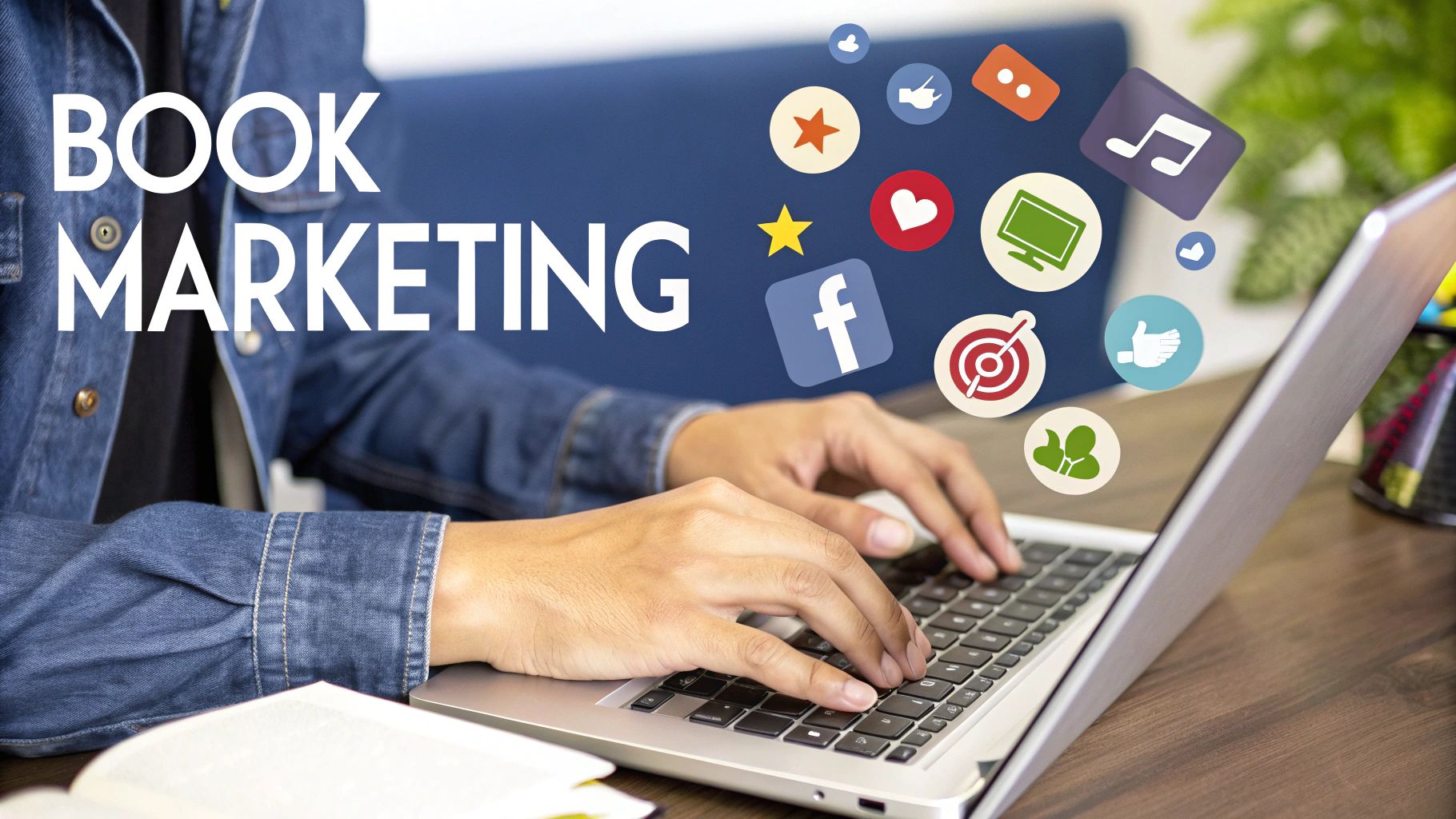
Here's the one thing you need to remember, no matter which path you take: you are your book's number one marketer. Your personal involvement isn't just a nice-to-have anymore; it's absolutely essential for any book to have a fighting chance in a crowded market.
What to Expect from a Traditional Publisher
Signing with a traditional publisher does give you a leg up. You gain access to an in-house team with industry connections and resources that would take an individual years to build.
But let's be realistic—those resources are not infinite. A publisher’s marketing budget is a pie, and the biggest slices always go to their lead titles, the handful of books they are banking on to become massive bestsellers.
Here’s what a publisher almost always handles:
- Trade Marketing: Getting your book in front of the big players—distributors, major bookstore chains like Barnes & Noble, and libraries—to convince them to place orders.
- Publicity Efforts: Sending advance reader copies (ARCs) to professional reviewers and media contacts to stir up some early buzz.
- Sales Materials: Designing the catalog copy and sales kits their teams use to pitch your book.
For most new or mid-list authors, this is where the publisher’s direct marketing push often ends. They handle the industry-facing side of things and then turn to you, expecting you to drive the direct engagement with readers.
The biggest change in publishing over the last decade is the expectation that every author must build their own audience. It doesn't matter if you're with a Big Five publisher or on your own. A publisher sees an author with a ready-made platform as a much, much safer bet.
The Self-Published Author as Marketer in Chief
When you self-publish, you’re not just the author; you’re the CEO, and marketing is your most critical department. You are 100% responsible for the entire promotional strategy, the execution, and the budget. While that sounds intimidating, it also means you have total creative freedom and a direct, unfiltered connection with your audience.
Successful indie authors quickly become masters of marketing. If you're looking for a roadmap, our complete guide on how to market your self published book is packed with real-world, actionable steps.
Your marketing to-do list as an indie author will likely include:
- Building Your Author Platform: This is your home base. It means a professional website, a growing email list, and a presence on the social media channels where your readers hang out.
- Managing Paid Advertising: Learning the ropes of Amazon Ads, Facebook Ads, or BookBub Ads to put your book directly in front of potential buyers.
- Chasing Reviews: Actively reaching out to book bloggers, influencers, and your first readers to gather the social proof that drives sales.
- Running Promotions: Strategically scheduling price drops, teaming up with other authors for book bundles, or offering deals to give sales a jolt.
No matter which publishing route you choose, having a solid online presence is non-negotiable. For a closer look at what works, check out these proven strategies for increasing book sales through social media. Think of it this way: every marketing skill you learn is an investment in your long-term career as an author.
Making the Right Choice for Your Author Career
So, we've laid out the pros and cons. Now comes the hard part: moving from a theoretical debate about traditional vs self-publishing to a decision that will shape your career. There’s no magic formula here—the "right" answer depends entirely on you, your goals, and the book you’ve poured your heart into.
To cut through the noise, let's look at a few common author scenarios. See if you recognize yourself in any of these profiles.
Which Publishing Path Fits Your Profile?
Finding the right fit often comes down to understanding your own motivations and what you want to achieve with this specific book.
-
The Debut Novelist Hunting for Prestige: If you've just finished a literary novel and dream of seeing it on a shelf at Barnes & Noble, a traditional deal is likely your target. You're looking for that stamp of approval from the industry, professional reviews, and the weight of a publishing house behind you. For this author, traditional publishing is the most direct route to that kind of validation and broad bookstore distribution.
-
The Niche Non-Fiction Guru: Are you an expert in a specialized field, like financial planning for freelancers or advanced drone photography? Your primary goal might be getting your timely information out to your audience fast, without anyone watering it down. Self-publishing is a game-changer here. It gives you the speed and total control needed to serve your niche and build authority, often by selling directly to your existing followers.
-
The Prolific Genre Author: Maybe you write romance or sci-fi and can finish a book every few months. The slow, methodical pace of traditional publishing would feel like driving with the emergency brake on. For you, self-publishing isn't just an option; it's a business model. The rapid release schedule and higher royalty rates are exactly what you need to build a massive backlist and a sustainable income stream.
The best choice isn't about which model is superior, but which one makes the most sense as a business decision for your book, right now. Many successful authors even use both paths for different projects throughout their careers.
A Few Final Questions to Ask Yourself
Before you commit, get brutally honest about your own resources and priorities. Your answers to these questions should make the path much clearer.
- What's my number one goal? Are you chasing industry recognition, complete creative freedom, the highest possible earnings per book, or just getting your story into readers' hands as quickly as possible?
- What's my budget? Do I have the capital to invest a few thousand dollars in top-notch editing, cover design, and formatting to make my self-published book competitive?
- How much time can I sink into marketing? Am I ready and willing to run my own book launch, from managing social media and newsletters to buying and analyzing ads?
Your answers will point you in the right direction. The publishing world has changed dramatically, and the rise of the author-entrepreneur is no accident. In 2023, an estimated 500,000 new self-published books hit the market in the US, compared to roughly 10,000 new titles from traditional publishers.
You can dive deeper into the current state of self-publishing statistics for more insights. That massive gap shows that for a huge number of writers, taking the reins of their publishing destiny is an incredibly powerful and viable choice.
Your Publishing Questions, Answered
Deciding between traditional and self-publishing brings up a ton of questions. Let's tackle some of the most common ones I hear from authors wrestling with this choice.
Do I Really Need an Agent to Self-Publish?
Nope, not at all. Think of a literary agent as the key that unlocks the door to traditional publishing houses. Their whole job is to represent your work and pitch it to editors.
When you self-publish, you're the publisher. You own the house, so you don't need an agent to let you in. You get to skip that entire process and go straight to creating your book. The trade-off is that you become the project manager, responsible for finding and hiring your own team of editors, designers, and formatters.
Can My Self-Published Book Ever Get Picked Up by a Traditional Publisher?
It can, but let's be realistic—it's a bit like winning the lottery. For a traditional publisher to take notice, your self-published book needs to have already achieved incredible success on its own. We're talking massive sales figures, thousands of reviews, and a proven, hungry audience.
A great example is The Martian by Andy Weir, which started as a self-published hit before a major publisher acquired it. But remember, stories like that are the exception, not the rule. The publisher is essentially buying a sure thing, which removes their financial risk.
What Are the Sneaky Costs of Self-Publishing I Might Miss?
It's easy to budget for the big things like editing and cover design, but a few other expenses often catch new authors by surprise.
- Marketing & Ads: Your book won’t find readers on its own. A serious marketing push, including paid ads on platforms like Amazon or Facebook, can easily run into the hundreds, if not thousands, of dollars.
- Your Own ISBNs: While some services provide a free one, buying your own ISBNs is essential if you want full control and the ability to distribute your book everywhere.
- Professional Formatting: Making sure your book’s interior looks polished and professional in both print and e-book formats often requires hiring a specialist.
These aren't just optional add-ons; they're critical investments if you want your book to look and feel as professional as anything coming from a major publisher.
Ready to turn your manuscript into a professionally published book with a team of experts guiding you every step of the way? BarkerBooks has helped over 7,500 authors reach a global audience. Learn more about our full-service publishing packages.
